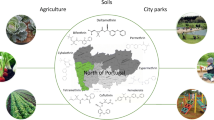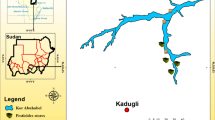Abstract
Purpose
The demand of rice by the increase in population in many countries has intensified the application of pesticides and the use of poor quality water to irrigate fields. The terrestrial environment is one compartment affected by these situations, where soil is working as a reservoir, retaining organic pollutants. Therefore, it is necessary to develop methods to determine insecticides in soil and monitor susceptible areas to be contaminated, applying adequate techniques to remediate them.
Materials and methods
This study investigates the occurrence of ten pyrethroid insecticides (PYs) and its spatio-temporal variance in soil at two different depths collected in two periods (before plow and during rice production), in a paddy field area located in the Mediterranean coast. Pyrethroids were quantified using gas chromatography–mass spectrometry (GC–MS) after ultrasound-assisted extraction with ethyl acetate. The results obtained were assessed statistically using non-parametric methods, and significant statistical differences (p < 0.05) in pyrethroids content with soil depth and proximity to wastewater treatment plants were evaluated. Moreover, a geographic information system (GIS) was used to monitor the occurrence of PYs in paddy fields and detect risk areas.
Results and discussion
Pyrethroids were detected at concentrations ≤57.0 ng g−1 before plow and ≤62.3 ng g−1 during rice production, being resmethrin and cyfluthrin the compounds found at higher concentrations in soil. Pyrethroids were detected mainly at the top soil, and a GIS program was used to depict the obtained results, showing that effluents from wastewater treatment plants (WWTPs) were the main sources of soil contamination. No toxic effects were expected to soil organisms, but it is of concern that PYs may affect aquatic organisms, which represents the worst case scenario.
Conclusions
A methodology to determine pyrethroids in soil was developed to monitor a paddy field area. The use of water from WWTPs to irrigate rice fields is one of the main pollution sources of pyrethroids. It is a matter of concern that PYs may present toxic effects on aquatic organisms, as they can be desorbed from soil. Phytoremediation may play an important role in this area, reducing the possible risk associated to PYs levels in soil.




Similar content being viewed by others
References
Albaseer SS, Rao RN, Swamy YV, Mukkanti K (2010) An overview of sample preparation and extraction of synthetic pyrethroids from water, sediment and soil. J Chromatogr A 1217(35):5537–5554
Alonso MB, Feo ML, Corcellas C, Vidal LG, Bertozzi CP, Marigo J, Secchi ER, Bassoi M, Azevedo AF, Dorneles PR, Torres JPM, Lailson-Brito J, Malm O, Eljarrat E, Barcelo D (2012) Pyrethroids: a new threat to marine mammals? Environ Int 47:99–106
Amweg EL, Weston DP, Ureda NM (2005) Use and toxicity of pyrethroid pesticides in the Central Valley, California, USA. Environ Toxicol Chem 24(4):966–972
Arias-Estevez M, Lopez-Periago E, Martinez-Carballo E, Simal-Gandara J, Mejuto JC, Garcia-Rio L (2008) The mobility and degradation of pesticides in soils and the pollution of groundwater resources. Agric Eco Environ 123(4):247–260
Aznar R, Albero B, Sanchez-Brunete C, Miguel E, Tadeo JL (2014) Multiresidue analysis of insecticides and other selected environmental contaminants in poultry manure by gas chromatography/mass spectrometry. J AOAC Int 97(4):978–986
Campo J, Masia A, Blasco C, Pico Y (2013) Occurrence and removal efficiency of pesticides in sewage treatment plants of four Mediterranean River Basins. J Hazard Mater 263:146–157
European Commission (2002) Review report for the active substance Cyfluthrin, 6843/VI/97-final
European Commission (2004) Review report for the active substance α-Cypermethrin, SANCO/4335/2000-final
European Commission (2005) Review report for the active substance Esfenvalerate, 6846/VI/97-final
Feo ML, Ginebreda A, Eljarrat E, Barcelo D (2010) Presence of pyrethroid pesticides in water and sediments of Ebro River Delta. J Hydrol 393(3-4):156–162
Fojut TL, Palumbo AJ, Tjeerdema RS (2012) Aquatic life water quality criteria derived via the UC Davis method: II. Pyrethroid insecticides. Rev Environ Contam Toxicol 216:51–103
Gan J, Lee SJ, Liu WP, Haver DL, KAbashima JN (2005) Distribution and persistence of pyrethroids in runoff sediments. J Environ Qual 34:836–841
Hill IR (1985) Aquatic organisms and pyrethroids. Pestic Sci 27:429–465
Huang LM, Thompson A, Zhang GL, Chen LM, Han GZ, Gong ZT (2015) The use of chronosequences in studies of paddy soil evolution: a review. Geoderma 237:199–210
Katagi T (2004) Photodegradation of pesticides on plant and soil surfaces. Rev Environ Contam Toxicol 182:1–189
Laskowski DA (2002) Physical and chemical properties of pyrethroids. Rev Environ Contam Toxicol 174:49–170
Mahabali S, Spagnoghe P (2014) Mitigation of two insecticides by wetlands plants: feasibility study for the treatment of agricultural runoff in Suriname (South America). Water Air Soil Pollut 225:1771
Maund SJ, Hamer MJ, Lane MCG, Farrelly E, Rapley JH, Goggin UM, Gentle WE (2002) Partitioning, bioavailability, and toxicity of the pyrethroid insecticide cypermethrin in sediments. Environ Toxicol Chem 21(1):9–15
Maund SJ, Campbell PJ, Giddings JM, Hamer MJ, Henry K, Pilling ED, Warinton JS, Wheeler JR (2012) Ecotoxicology of synthetic pyrethroids. Top Curr Chem 314:137–165
Money E, Carter GP, Serre ML (2009) Using river distances in the space/time estimation of dissolved oxygen along two impaired river networks in New Jersey. Water Res 43(7):1948–1958
Moore MT, Cooper CM, Smith S, Jr Cullum RF, Knight SS, Locke MA, Bennett ER (2009) Mitigation of two pyrethroid insecticides in Mississippi Delta constructed wetland. Environ Pollut 157:250–256
Moreno-Ramón H, Marqués-Mateu A, Ibáñez-Asensio S, Gisbert JM (2015) Wetland soils under rice management and seawater intrusion: characterization and classification. Spa J Soil Sci 5(2):111–129
Nawaz MF, Bourrie G, Trolard F, Mouret JC, Henry P (2013) Effects of agronomic practices on the physico-chemical properties of soil waters in rice culture. Turk J Agric For 37(2):195–202
Oros DR, Werner I (2005) Pyrethroid insecticides: an analysis of use patterns, distributions, potential toxicity and fate in the Sacramento-San Joaquin Delta and Central Valley. White Paper for the Interagency Ecological Program. SFEI Contribution 415. San Francisco Estuary Institute, Oakland, CA
Pascual-Aguilar J, Andreu V, Gimeno-Garcia E, Pico Y (2015) Current anthropogenic pressures on agro-ecological protected coastal wetlands. Sci Total Environ 03:190–199
Soil Survey Staff (2014a) Soil survey field and laboratory methods manual. Soil survey investigations report no. 51, version 2.0. In: Burt R, Soil Survey Staff (eds). U.S. Department of Agriculture, Natural Resources Conservation Service, Washington, p 407
Soil Survey Staff (ed) (2014b) Keys to soil taxonomy, 12th edn. USDA-Natural Resources Conservation Service, Washington, p 372
Song Y, Kai J, Song X, Zhang W, Li L (2015) Long-term toxic effects of deltamethrin and fenvalerate in soil. J Hazard Mater 289:158–164
Weston DP, Holmes RW, You J, Lydy MJ (2005) Aquatic toxicity due to residential use of pyrethroid insecticides. Environ Sci Technol 39(24):9778–9784
Weston DP, Ramil HL, Lydy MJ (2013) Pyrethroid insecticides in municipal wastewater. Environ Toxicol Chem 32(11):2460–2468
Zhou JL, Rowland S, Mantoura RFC (1995) Partition of synthetic pyrethroid insecticides between dissolved and particulate phases. Water Res 29:1023–1103
Acknowledgments
Authors wish to thank INIA for the predoctoral fellowship (R. Aznar) and Spanish Ministry of Economy and Competitiveness RTA2014-00012-C03-01 for financial support and Jonathan Villanueva Martín for his contribution to this work.
Author information
Authors and Affiliations
Corresponding author
Additional information
Responsible editor: Maria Manuela Abreu
Electronic supplementary material
Below is the link to the electronic supplementary material.
ESM 1
(DOCX 95 kb)
Rights and permissions
About this article
Cite this article
Aznar, R., Moreno-Ramón, H., Albero, B. et al. Spatio-temporal distribution of pyrethroids in soil in Mediterranean paddy fields. J Soils Sediments 17, 1503–1513 (2017). https://doi.org/10.1007/s11368-016-1417-2
Received:
Accepted:
Published:
Issue Date:
DOI: https://doi.org/10.1007/s11368-016-1417-2




